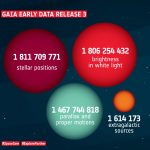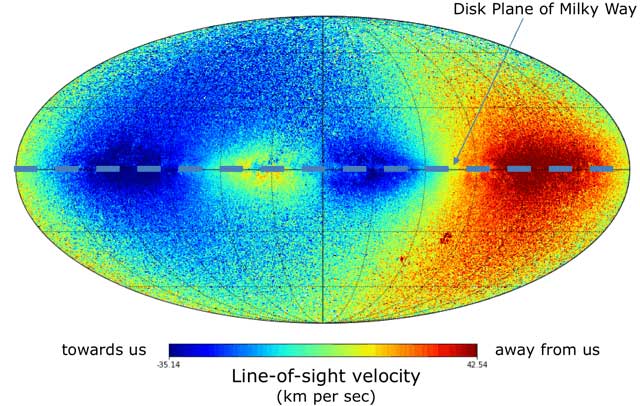

View larger. | Image via ESA.
ESA announced this morning (December 3, 2020) that its Early Data Release 3 from the great Gaia space observatory is now public. This space observatory – which focuses on astrometry, the measurements of the positions of stars over time – is giving us a 3D map of our Milky Way galaxy.
Imagine that: we’ll know how billions of stars in our galaxy are moving, in real time.

Here are some results from Gaia’s 2nd data release. This ia an all-sky map showing how about a billion stars are moving toward or away from our sun. It was made possible because Gaia’s measures precise locations of these stars, over and over again. When you look at this map, you’re seeing a large-scale pattern caused by rotation of our Milky Way galaxy. Image via DPAC/ ESA/ STFC/ National Archives.
ESA said this data release:
… contains detailed information on more than 1.8 billion sources, as measured by the Gaia spacecraft. This represents an increase of more than 100 million sources over the previous data release (Gaia DR2), which was made public in April 2018.
Of course, it’s not the increase in numbers of stars that’s so amazing. It’s the fact that so many stars are having their locations measured so many times. It’ll be months and years before we see the results of this knowledge, in future studies by astronomers. The earlier data release led to an astounding wealth of interesting results, too.
We’re looking forward to this next batch!
ESA said the December 3 data release includes:
1,811,709,771 sources with positions to provide the best ever sky map
1,467,744,818 sources with parallax and proper motion to reveal their distances and motions
1,806,254,432 sources with the measurement of their brightness in white light
1,542,033,472 sources with the brightness of the objects in blue light
1,554,997,939 sources with the brightness of the objects in red light (a comparison of the blue and the red light provides information of the temperature of the object)
1,614,173 extragalactic sources to provide a reference frame for measuring ‘absolute’ positions and motions.
We’ll have more about Gaia’s 3rd data release soon, but, for now, look here for more information.
Bottom line: The much-anticipated 3rd data release from the Gaia space observatory arrived on December 3, 2020.
Read more: Gaia’s 2nd data release: 1.7 billion stars!
from EarthSky https://ift.tt/36zFTSH


View larger. | Image via ESA.
ESA announced this morning (December 3, 2020) that its Early Data Release 3 from the great Gaia space observatory is now public. This space observatory – which focuses on astrometry, the measurements of the positions of stars over time – is giving us a 3D map of our Milky Way galaxy.
Imagine that: we’ll know how billions of stars in our galaxy are moving, in real time.

Here are some results from Gaia’s 2nd data release. This ia an all-sky map showing how about a billion stars are moving toward or away from our sun. It was made possible because Gaia’s measures precise locations of these stars, over and over again. When you look at this map, you’re seeing a large-scale pattern caused by rotation of our Milky Way galaxy. Image via DPAC/ ESA/ STFC/ National Archives.
ESA said this data release:
… contains detailed information on more than 1.8 billion sources, as measured by the Gaia spacecraft. This represents an increase of more than 100 million sources over the previous data release (Gaia DR2), which was made public in April 2018.
Of course, it’s not the increase in numbers of stars that’s so amazing. It’s the fact that so many stars are having their locations measured so many times. It’ll be months and years before we see the results of this knowledge, in future studies by astronomers. The earlier data release led to an astounding wealth of interesting results, too.
We’re looking forward to this next batch!
ESA said the December 3 data release includes:
1,811,709,771 sources with positions to provide the best ever sky map
1,467,744,818 sources with parallax and proper motion to reveal their distances and motions
1,806,254,432 sources with the measurement of their brightness in white light
1,542,033,472 sources with the brightness of the objects in blue light
1,554,997,939 sources with the brightness of the objects in red light (a comparison of the blue and the red light provides information of the temperature of the object)
1,614,173 extragalactic sources to provide a reference frame for measuring ‘absolute’ positions and motions.
We’ll have more about Gaia’s 3rd data release soon, but, for now, look here for more information.
Bottom line: The much-anticipated 3rd data release from the Gaia space observatory arrived on December 3, 2020.
Read more: Gaia’s 2nd data release: 1.7 billion stars!
from EarthSky https://ift.tt/36zFTSH

Aucun commentaire:
Enregistrer un commentaire